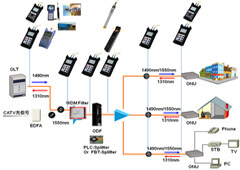Vital Attributes to Look for in Optical Fiber Screening Equipment
When assessing optical fiber screening devices, a number of crucial functions warrant careful consideration to guarantee optimal performance and dependability. Compatibility with existing sector standards enhances capability, while sophisticated dimension abilities, including TDR and OTDR testing, offer crucial understandings into network integrity. Comprehending these functions will drop light on exactly how to choose the best devices for your particular requirements.
Accuracy and Precision
Precision and accuracy are crucial parameters in the examination of optical fiber screening devices. These 2 characteristics make certain that dimensions reflect real performance of fiber optic systems, which is vital for effective network installation, maintenance, and troubleshooting. Precision describes the distance of a gauged worth to the actual worth, while accuracy signifies the repeatability of measurements under unmodified problems.
When picking optical fibre testing devices, it is necessary to think about instruments that supply high precision and precision to reduce errors in data interpretation. Devices such as optical time-domain reflectometers (OTDRs) and power meters must have calibration devices to make sure constant efficiency over time. Furthermore, the specifications supplied by producers need to information the tools's dimension uncertainty, which directly impacts the reliability of test outcomes.
Furthermore, the performance of optical fiber screening devices can be affected by ecological elements, such as temperature and moisture. Selecting equipment designed to reduce these variables will enhance measurement integrity. In verdict, buying optical fibre screening devices with robust precision and precision features is basic for preserving optimal network efficiency and making certain the honesty of fibre optic communications.

User-Friendly Interface
The performance of optical fibre screening tools is not entirely determined by its accuracy and accuracy; an user-friendly user interface plays a significant function in enhancing operational performance. A well-designed interface streamlines the interaction between the professional and the equipment, permitting an extra intuitive understanding of complicated features.
Key features of an easy to use user interface include clear navigation food selections, sensible layouts, and quickly available controls. These elements allow specialists to perform tests quickly without substantial training, reducing the probability of customer mistake - ofda. Aesthetic indicators such as development bars, informs, and visual representations of information can substantially boost the user experience by supplying prompt responses on the testing process.
In addition, personalized settings can even more improve operations by enabling customers to readjust criteria according to details screening needs. This adaptability not only saves time however likewise guarantees that the devices fulfills varied application demands.
Including assistance features, such as tooltips and thorough guidebooks, into the interface can additionally empower users, promoting self-sufficiency and confidence in running the equipment. Ultimately, a straightforward interface is crucial for maximizing the capacity of optical fiber testing devices, leading to a lot more reliable and effective screening end results.
Mobility and Sturdiness
Transportability and resilience are critical attributes of optical fibre screening tools, guaranteeing that it can stand up to the roughness of various atmospheres while staying very easy to transport. Specialists commonly operate in address diverse settings, from telecommunications hubs to remote setups, making it essential that testing tools are lightweight and small (ofda). Devices made with portability in mind generally features ergonomic manages and situations that promote easy movement, thus enhancing operational efficiency on-site
Sturdiness is similarly necessary, as optical fiber screening tools is usually revealed to harsh problems, consisting of temperature level variations, dampness, and physical effects. Tools built with tough materials such as reinforced plastics or metal real estates are much better matched for these settings, decreasing the threat of damages during use and transportation. In addition, tools with water and dust resistance ratings, such as IP ratings, ensures reliable efficiency in tough conditions.
Compatibility With Criteria
Guaranteeing compatibility with industry criteria is crucial for optical fibre testing tools, as it straight impacts the integrity and credibility of test outcomes. Optical fiber networks go through stringent efficiency requirements established by numerous companies, including the Telecoms Market Association (TIA) and the International Electrotechnical Payment (IEC) Checking equipment needs to stick to these criteria to guarantee that measurements correspond and similar across different systems and settings.
When choosing optical fibre testing tools, individuals must confirm that the device satisfies relevant criteria essential to their certain application, such as those associated to attenuation, transmission capacity, and crosstalk. Equipment that is certified with established requirements not only assists in achieving exact outcomes however also promotes interoperability amongst devices from various suppliers.
Additionally, compatibility with standards ensures that the devices can be utilized in regulatory compliance circumstances, which is essential for tasks in fields such as telecommunications, aerospace, and army applications. Therefore, buying optical fibre screening tools that lines up with present sector requirements is the original source a basic aspect of preserving high quality assurance and attaining optimal network performance.
Advanced Measurement Abilities
Advanced measurement abilities are a defining feature of modern optical fibre testing equipment, enabling comprehensive analysis of network performance. These capacities make certain that specialists can assess vital specifications such as signal loss, dispersion, and bandwidth, which are vital for maintaining optimum interaction effectiveness.
One secret aspect is the ability to perform time-domain reflectometry (TDR) and optical time-domain reflectometry (OTDR) examinations. These methods enable users to recognize mistakes, determine the length of fibers, and see post figure out the place of defects with remarkable accuracy - ofda. In addition, sophisticated equipment often consists of the ability to measure optical power degrees, assisting to assess the total health and wellness of the network and ensure conformity with the needed specifications.
In addition, some testing tools offer sophisticated formulas for real-time evaluation, allowing quicker medical diagnosis and troubleshooting. In conclusion, investing in optical fiber testing tools with sophisticated measurement abilities is vital for ensuring network dependability and performance in today's requiring telecoms landscape.
Verdict
